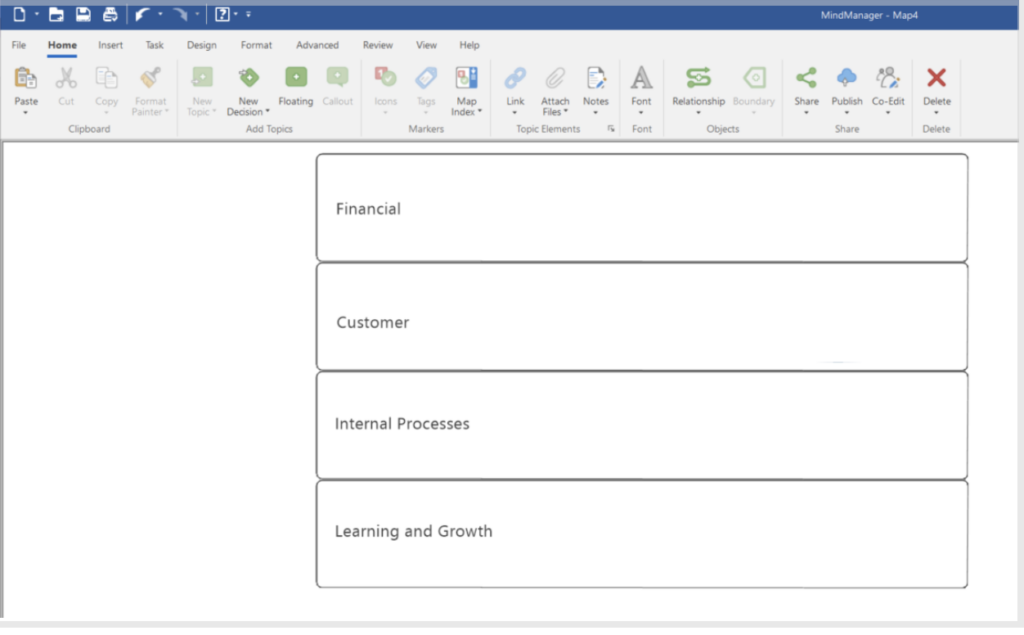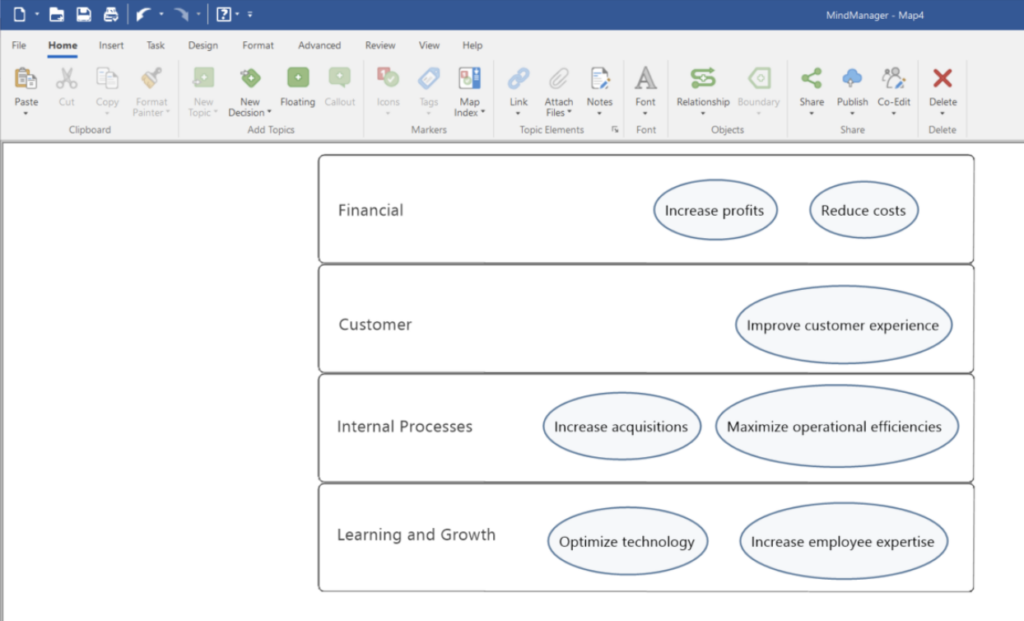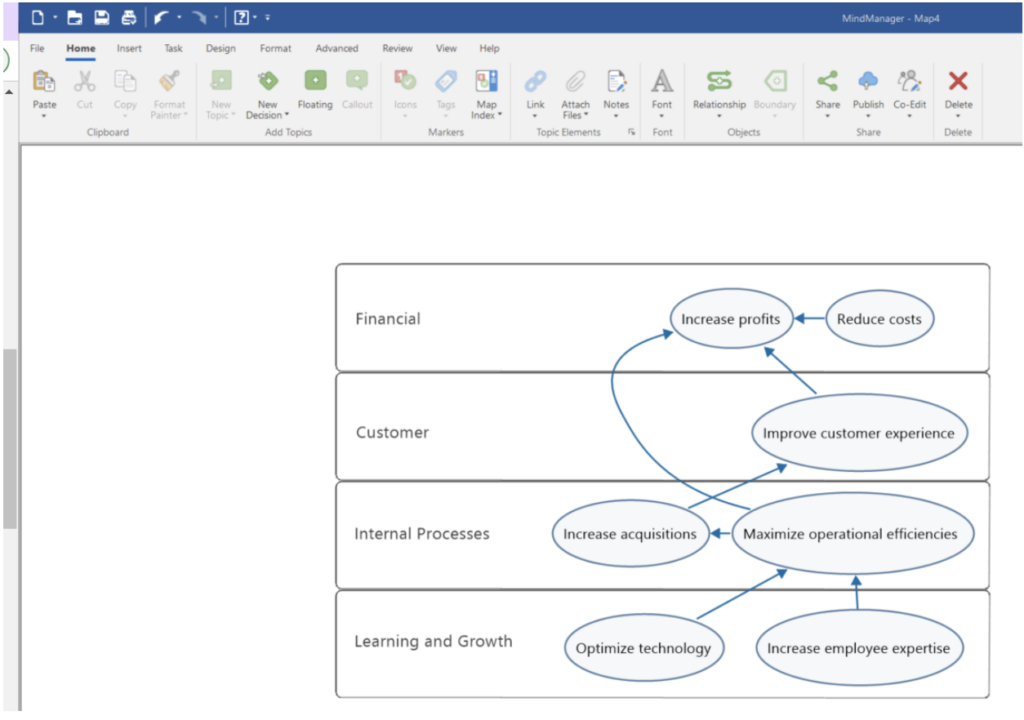A strategy map is a valuable planning tool that provides a big-picture view of your business goals, the steps needed to achieve these goals, and how various elements of these goals relate to one another. They can help organizations and businesses visualize how they will achieve future goals and how these goals are connected to other tasks and objectives.
Strategy maps are intentionally simplistic in their structure, which highlights the essential cause-and-effect relationships between the various components of a business strategy. These maps can be created using pen and paper or common applications such as documents and spreadsheets. However, a more effective method is to use visual diagramming tools that make it easy to add the necessary information and adjust the map as needed until you’ve thoroughly laid out your goals.
In this article, we will explore what a strategy map is, its uses and benefits for your organization, and how a tool like MindManager® helps you create interactive visual diagrams like strategy maps.
How does strategy mapping fulfill business needs?
Any strategic communication effort may be enhanced with a strategy map. Most people are visual learners, so the process of developing a strategy map helps them picture what you hope to accomplish and how their efforts contribute to reaching organizational objectives.
Within every organization is a collection of independent, interconnected elements called a value chain. These elements include actions like primary business activities and entities like core departments, each of which contributes to how the company creates value and drives business success.
A strategy map illustrates these elements by grouping objectives into four perspectives or categories:
- Financial activities. The financial perspective looks at how to improve revenue and lower costs. It is measured by productivity, which is connected to your short-term financial objectives and revenue growth, which in turn stems from achieving your long-term financial objectives.
- Customer relationships. The customer perspective identifies how your organization provides value to customers with your products or services. Keep in mind that customer satisfaction applies not only to winning new business, but also to maintaining and cultivating relationships with your existing customers.
- Internal processes. The internal processes perspective looks at how operational processes and activities can be enhanced or made more efficient to help meet customer and financial goals.
- People, learning, and growth. The learning and growth perspective relates to how your technology and people support overall business objectives. It defines the necessary knowledge, skills, and systems needed to deliver the intended value to customers, and any gaps therein.
Strategy maps help businesses understand the causal relationships between these four perspectives.
For example, if you invest resources to improve employees’ knowledge and skills, you may improve your internal processes. Better internal processes lead to improved customer experiences, which in turn translate to better financial outcomes.
Benefits of strategy maps for business
Companies often have many teams working on a variety of projects that range in size and complexity. As a result, teams might not be aware of how their work impacts others. Strategy maps create a visual representation of how all the goals across your key business perspectives are linked together. This ensures that employees understand how their individual goals ultimately contribute to the company’s overall strategic objectives.
The perspectives used to create a strategy map can be modified to suit specific business needs. You can easily rename or reorganize the perspectives to reflect what is most important to your company. For example, most for-profit organizations place the financial perspective at the top of their strategy map. Public sector and non-profit companies, however, are mission-driven and commonly put the customer or stakeholder perspective on top.
Because strategy maps are single-page diagrams, they make organizational goals and the way they connect to each other easy to understand. Unlike lengthy written documents, a strategy map uses visual indicators such as lines and arrows to highlight how various objectives all work toward achieving high-level business goals.
Strategy maps are also useful tools for conducting gap analyses, which helps to identify and resolve issues that impede your ability to reach your strategic goals. In building a strategy map, companies must clarify their goals and the objectives needed to accomplish those goals. As such, a strategy map helps identify gaps within the overall business strategy.
How to create a strategy map in MindManager
A strategy map puts all goals across your key business perspectives on a single page, giving everyone in the organization a visual representation of the cause-and-effect relationship between them. Take the following steps to create a strategy map using MindManager’s tools:
Identify your objectives
Each strategic objective can be contained in a shape, such as an oval, and grouped into your chosen perspectives such as internal processes or customer relationships. You can develop your objectives in MindManager using several templates or blank mind maps.
For this article, we will create a strategy map using a blank, free-form template. To get started, open MindManager and click “New” from the navigation menu. Then, select “Free-Form” from the collection of blank templates and click “Create Map” in the preview screen.
Before you can add the strategic objectives, you first need to create your organizational perspectives. To do so, insert four rounded rectangle shapes. Then, add text boxes to label each perspective.

Once the perspectives are established, you can now add the strategic objectives in their corresponding perspective categories. Less is more when it comes to a strategy map, so it is a best practice to track between 12 and 18 objectives.

Highlight the relationships between objectives
Now it is time to show the casual relationships between the objectives using arrows. For example, if one of your objectives in the learning and growth perspective is to improve information sharing, one result is that employees will become more efficient in their work (internal processes). More efficient employees are happier in their job role, which in turn improves the customer experience and increases business profits.

Cascade your strategy map
Once you have a high-level strategy map of company goals and the steps required to achieve them, you can create local copies of the main map or download it in an editable format. These copies can be distributed to different departments who can customize the map using their specific objectives and relational indicators.
MindManager makes it easy to create strategy maps using dozens of customizable templates.

